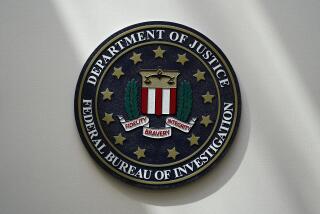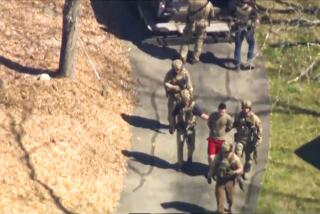Cuban-born spy credited with exposing Fidel Castro’s U.S. operatives

- Share via
The Cuban spy released to the United States as part of a campaign to improve relations between Washington and Havana was instrumental in breaking some of the Castro regime’s most notorious espionage missions, officials said Thursday.
Although neither President Obama nor U.S. intelligence agency spokesmen identified the freed operative, Latin American media said he was Rolando Sarraff Trujillo, a former Cuban Interior Ministry cryptographer.
Little is known in the United States about Sarraff Trujillo, who was arrested Nov. 2, 1995, and accused of gathering intelligence for a foreign country, Argentina’s Infobae news site reported.
Sarraff Trujillo was convicted and sentenced to 25 years in prison, the first 16 years spent in isolation at a special maximum-security penal colony in Guanajay, the news site said.
In announcing the spy swaps that are said to be a prelude to normalizing U.S.-Cuba relations, Obama said the Cuban operative freed Wednesday was “one of the most important intelligence agents that the United States has ever had in Cuba.”
The spy “provided the information that led to the identification and conviction of Defense Intelligence Agency senior analyst Ana Belen Montes; former Department of State official Walter Kendall Myers and his spouse Gwendolyn Myers; and members of the Red Avispa network, or ‘Wasp Network,’ in Florida, which included members of the so-called Cuban Five,” Brian Hale, spokesman for the director of national intelligence, said in a statement Thursday.
Belen Montes is serving a life sentence for passing intelligence to Cuba for 17 years. Walter Kendall Myers is also serving a life sentence for spying on behalf of Cuba for 30 years. His wife was sentenced to seven years for complicity in the security breaches.
A senior administration official, who briefed journalists on condition he not be identified, said of the unidentified spy credited with busting the Cuban operations that “this intelligence asset did heroic work for the United States at great risk to himself, enabling the prosecution of a number of individuals, including the Cuban Five.”
He said the collaborator had been in a Cuban prison for nearly 20 years, and his release in exchange for the last three of the Cuban Five still in U.S. detention “was an important principle for us” in negotiating the prisoner swap.
Sarraff Trujillo, known as “Roly,” was caught by Cuban counterintelligence agents after he reportedly provided classified information to a colleague in the Science and Technology Department of Cuba’s Directorate of Intelligence who was planning to defect to the United States, according to a May 27, 2012, posting on the Cuba Confidential blog of former U.S. Defense Intelligence Agency Cuba analyst Chris Simmons.
Sarraff Trujillo was arrested when the colleague, Jose Cohen Valdez, “began indiscreetly spending the considerable cash the CIA paid for Sarraff Trujillo’s treasure trove of intelligence,” Simmons wrote. Cohen and another Cuban intelligence operative involved in the passage of secrets to the CIA escaped, but Sarraff Trujillo was arrested and prosecuted, the report titled “An Imperfect Defection” said.
The case of the Cuban Five sprang from U.S. intelligence penetration of the Wasp Network, a series of Cuban missions aimed at surveillance of radical Cuban emigre groups in southern Florida suspected of financing and plotting assassination attempts on Fidel Castro in the 1980s and 1990s. The information leading to the arrests of the Cuban spies was provided by Sarraff Trujillo, according to U.S. and Cuban officials.
The five men charged with operating as unregistered foreign agents conceded they were in the United States to gather intelligence on “terrorist exiles” but insisted during their trial that their operations were intended to protect the Castro regime from further attacks, not to steal U.S. secrets or undermine national security.
Cuba’s 14ymedio website also identified Sarraff Trujillo as one of three possible captives released to the United States in the groundbreaking agreement Wednesday to normalize U.S.-Cuba ties after 55 years of bitter division. The other two mentioned as fitting the profile of a former security insider were Ernesto Borges Perez and Claro Fernando Hernandez.
Infobae didn’t detail the source of its information about Sarraff Trujillo. But it included photos of the man that appear to go back to his teens or early 20s, the source of which might have been family members.
The news agency said Sarraff Trujillo had been delivered to the United States on the same plane that brought jailed U.S. contractor Alan Gross back from five years’ imprisonment in Cuba for attempting to install communications equipment without government approval. It quoted his parents as saying they had had no word on the fate of their son for months, having been turned away from the Cuban prison when they last tried to visit him earlier this year.
Sarraff Trujillo’s age wasn’t reported in the few media reports that named him, but he appears in the latest picture, which Infobae said was taken during a prison visit in April, to be in his late 50s or early 60s.
Follow @cjwilliamslat for the latest international news 24/7
More to Read
Sign up for Essential California
The most important California stories and recommendations in your inbox every morning.
You may occasionally receive promotional content from the Los Angeles Times.










